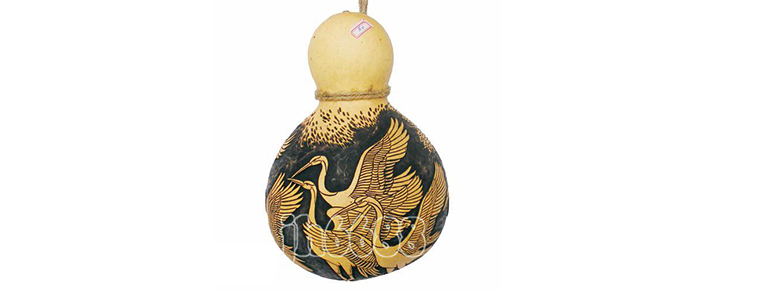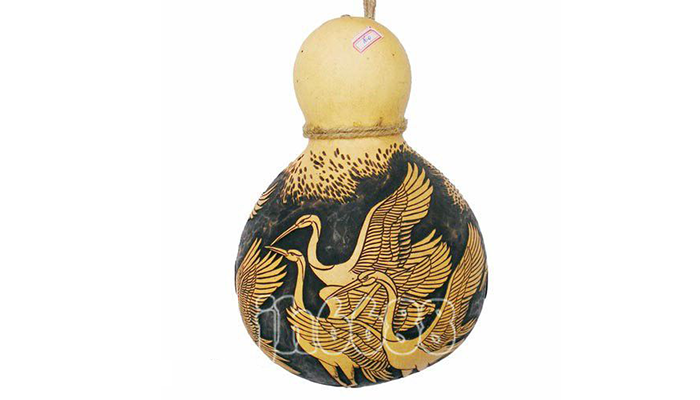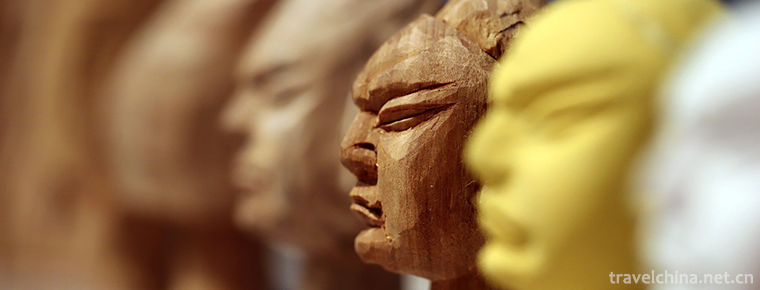2019-06-18

- By ChinaWiki.net
- Chinese Edition
- 2019-05-03
Gourd sculpture
There are two techniques for carving gourds. One is to use three kinds of special steel needles, large, medium and small, to carve the landscape, flowers and characters in the gourd skin with thin lines, and then coat them with pine ink, so that the lines become obvious. Experts call this technique "description".
Another technique is to hollow out the shell of the gourd with a carving knife, and outline the landscape, flowers and characters to be depicted with rough lines. Experts call this technique "sculpture". After the picture is carved, it is decorated with a circular plaque pattern on the top and bottom of the gourd. Finally, it is equipped with a chemical or silver base, and the work is completed.
brief introduction
There are two kinds of gourd carving: gourd carving and gourd carving. The main characteristics of gourd carving differ from other gourd carving tools are that it is neither a simple model nor a simple sculpture, but a comprehensive gourd carving process that combines model, sculpture, fire painting and splicing. Cucurbit sculpture is mostly composed of stitching and assembling, most commonly supplemented by sculpture, fire painting, and also supplemented by standardization. The materials used are natural gourds of different varieties and sizes. After cutting, the gourds are reassembled into gourd utensils with different shapes by using different parts. The artistic beauty of gourd carving will be strengthened on the basis of splicing and combining and then carving. The main carving methods are Yang carving, Yin carving, penetrating carving, Yang carving flat, Yang carving sandy land, Yin carving and Yang carving, double sketch and so on. The main knife methods include straight knife, push knife, lateral knife, inside knife, forward knife, retrograde knife, pick knife, stacking knife, cutting knife, etc. These carving and knife methods are basically borrowed from bamboo carving, wood carving and other crafts. The application of knives should be stable (calm and calm), accurate (high accuracy), light (appropriate force), slow (slow and steady) and skillful (skilled knife method). Only in this way can we carve a beautiful gourd handicraft. Cucurbita carving, as its name implies, is carved on the cucurbita, making it a gourd art for people to appreciate. Cucurbit carving is a kind of three-dimensional art, while carving gourds is not, all on the surface of the gourd composition. It is said that carved gourds were first spread among the people in Gansu Province. People used knives and needles to carve gourds and freely depicted simple patterns of flowers, grass, insects and fish as ornaments. Later, through continuous exploration and research by artists, the craft level has been continuously improved, and a special gourd carving art has gradually formed. Cucurbita carving was originally a needle method, but now it has created a knife carving method, there have been a variety of hollow gourd. Some also created famous landscape paintings imitating ink, freehand brushwork, and imitated the rhyme of Wu Changshuo, Ren Bonian, Xu Beihong and Qi Baishi to create gourds with unique style.

Ask a Question
Your email address will not be published.



0 Questions